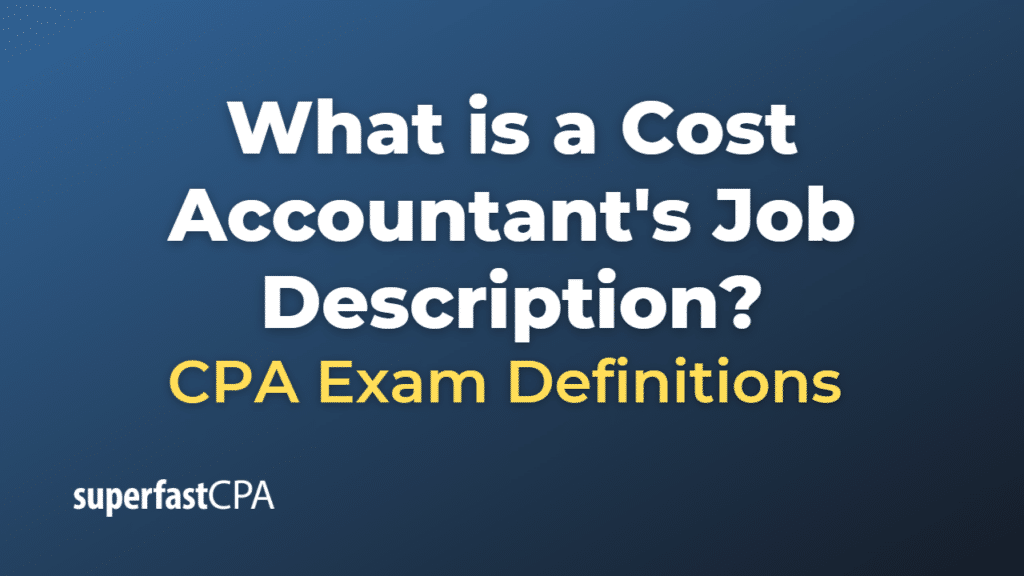Cost Accountant Job Description
A cost accountant is a financial professional responsible for identifying, measuring, and analyzing costs associated with an organization’s production, operations, and projects. Their primary goal is to help management make informed decisions regarding cost control, pricing, budgeting, and resource allocation to improve profitability and efficiency. A cost accountant’s job description may include the following duties and responsibilities:
- Collect and analyze cost data: Gather and examine cost information related to materials, labor, overhead, and other expenses to determine the cost structure of products, services, or projects.
- Implement and maintain cost accounting systems: Develop and maintain cost accounting systems, procedures, and controls to ensure accurate and timely cost information.
- Cost allocation and analysis: Allocate indirect costs to different cost centers, departments, or products using appropriate allocation methods, and analyze cost trends to identify areas of potential improvement.
- Inventory valuation and management: Monitor and manage inventory levels, perform periodic inventory counts, and calculate the value of inventory using appropriate costing methods, such as FIFO, LIFO, or weighted average cost.
- Budgeting and forecasting: Assist in the preparation of budgets and forecasts by estimating future costs based on historical data, trends, and management input. Compare actual costs against budgeted figures and provide variance analysis to support decision-making.
- Pricing analysis: Analyze costs and profit margins to support pricing decisions, ensuring that products and services are priced competitively and contribute to overall profitability.
- Cost control and reduction: Identify opportunities for cost reduction and efficiency improvements by analyzing cost data and working with management to implement cost-saving initiatives.
- Financial reporting: Prepare periodic cost reports, such as standard cost updates, product cost analysis, and gross margin analysis, to support management decision-making and financial reporting.
- Compliance and internal controls: Ensure compliance with relevant accounting standards, regulations, and internal policies related to cost accounting and maintain a strong system of internal controls to safeguard company assets.
- Collaboration with cross-functional teams: Work closely with other departments, such as production, purchasing, and sales, to gather information, analyze costs, and implement cost-saving initiatives.
A cost accountant typically holds a bachelor’s degree in accounting, finance, or a related field and may possess a professional certification, such as the Certified Management Accountant (CMA) or Certified Cost Accountant (CCA). They should have strong analytical, problem-solving, and communication skills, as well as proficiency in accounting software and other relevant tools.
Example of a Cost Accountant’s Job Description
Let’s consider an example of a cost accountant working at a manufacturing company called “BestTech Electronics” that produces electronic devices.
Sarah is a cost accountant at BestTech Electronics, and her job involves various tasks and responsibilities to help the company manage its costs effectively and make informed decisions. Here’s a snapshot of her activities:
- Collect and analyze cost data: Sarah gathers data on the costs of raw materials, labor, and overhead expenses related to the production of electronic devices. She analyzes this data to determine the cost structure of each product and identify any potential cost inefficiencies.
- Implement and maintain cost accounting systems: Sarah develops and maintains a cost accounting system that tracks all production costs and provides accurate and timely cost information to management.
- Cost allocation and analysis: Sarah allocates indirect costs, such as factory rent and utilities, to different product lines using appropriate allocation methods. She analyzes cost trends to identify areas where BestTech Electronics could potentially reduce expenses or improve efficiency.
- Inventory valuation and management: Sarah regularly monitors inventory levels and conducts periodic inventory counts. She calculates the value of the inventory using the FIFO (first-in, first-out) costing method and provides reports on inventory valuation to management.
- Budgeting and forecasting: Sarah assists the finance team in preparing annual budgets and quarterly forecasts by estimating future production costs based on historical data, current trends, and input from management.
- Pricing analysis: Sarah analyzes the costs and profit margins of each product to support pricing decisions, ensuring that the electronic devices are competitively priced and contribute to the company’s overall profitability.
- Cost control and reduction: Sarah identifies opportunities for cost reduction by analyzing production processes and working with the operations team to implement cost-saving initiatives, such as negotiating better prices with suppliers or improving production efficiency.
- Financial reporting: Sarah prepares periodic cost reports, such as product cost analysis and gross margin analysis, to support management decision-making and financial reporting.
- Compliance and internal controls: Sarah ensures that BestTech Electronics’ cost accounting practices comply with relevant accounting standards and regulations, and maintains a robust system of internal controls to safeguard company assets.
- Collaboration with cross-functional teams: Sarah works closely with other departments, such as purchasing and sales, to gather information, analyze costs, and implement cost-saving initiatives that benefit the entire organization.
In this example, Sarah’s role as a cost accountant at BestTech Electronics involves a wide range of tasks and responsibilities focused on managing costs, supporting decision-making, and ultimately contributing to the company’s overall profitability and success.













